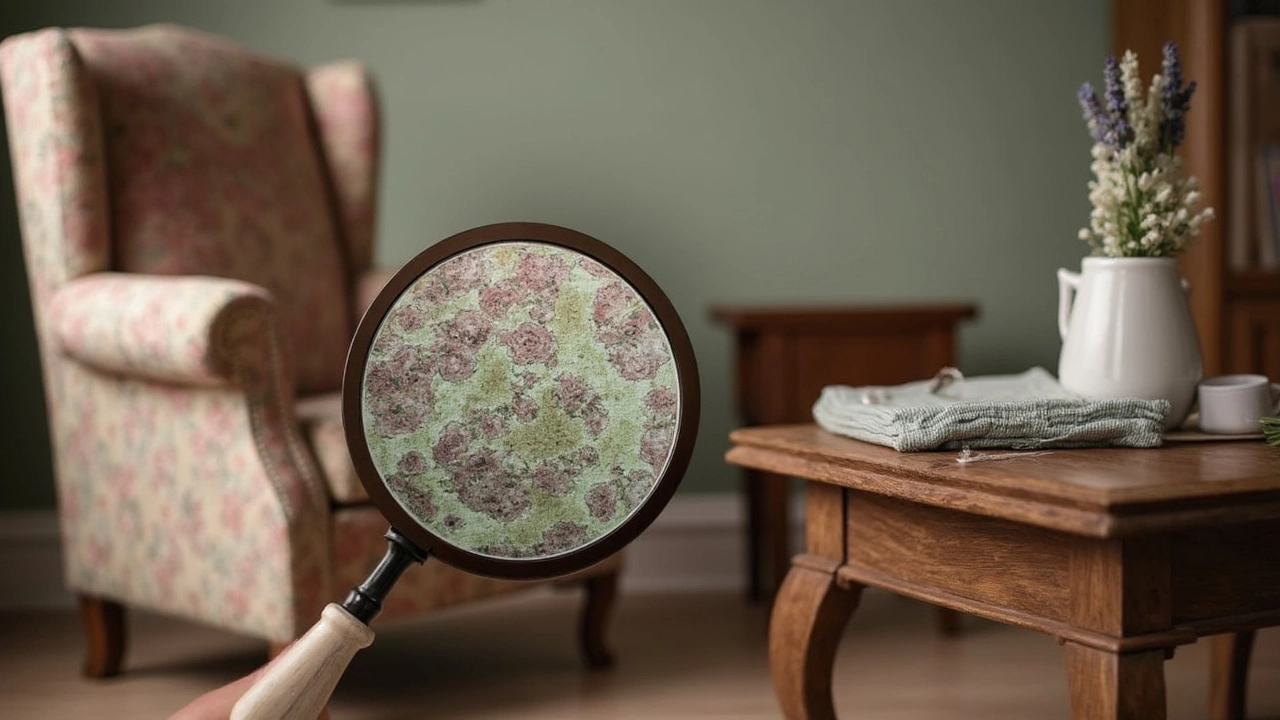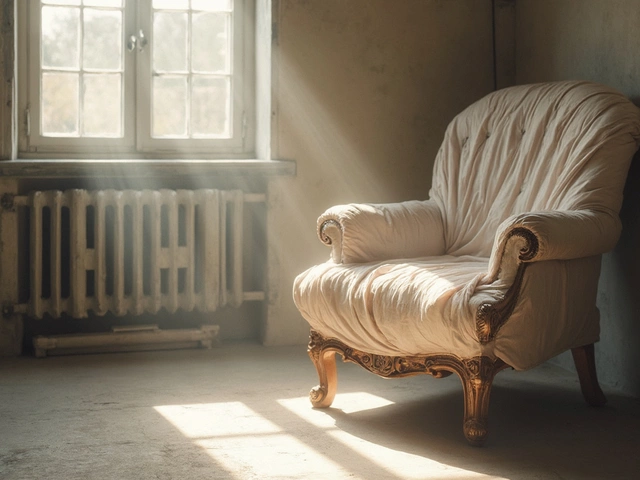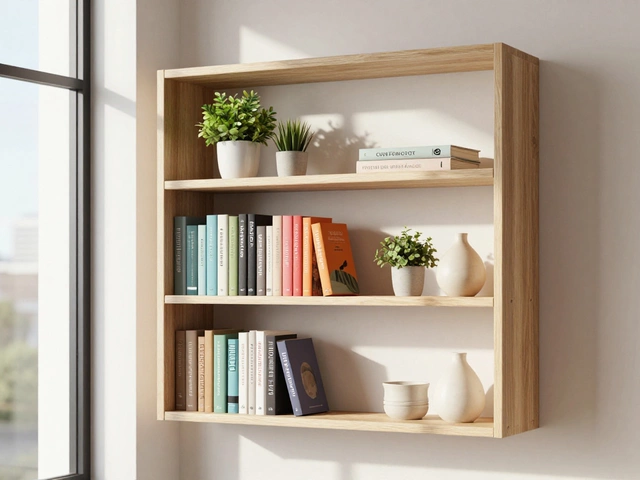Mold loves dark, humid places—the exact kind of spot most storage units turn into if you're not careful. One bad choice, like wrapping a sofa in plastic or picking a damp garage, and suddenly you’re dealing with musty smells and ugly stains. Once mold gets in, it’s nearly impossible to get all the spores out of soft fabrics or wood.
If you want your furniture to come out of storage looking as good as it did going in, you need a game plan. Start with location. Avoid basements, garages, or sheds–they’re almost always too damp. If you have to use them, don’t toss stuff straight on a concrete floor. Moisture seeps up from the ground. Put your furniture on pallets or even a few old bricks—it’s way better than nothing. And don’t forget to check for leaks or drips above your storage spot. Tiny cracks can let tons of moisture in over time.
- Why Mold Attacks Furniture in Storage
- Pick the Right Storage Location
- Wrapping and Treating Furniture Properly
- Humidity Hacks and Air Flow Tricks
- Cheap DIY Mold Prevention Tips
- Spotting Trouble Early and Fixing It
Why Mold Attacks Furniture in Storage
Mold isn’t picky—it goes after anything that’s got a bit of moisture and something it can munch on. Most storage furniture like couches, wooden tables, and mattresses all have the perfect ingredients: organic material (like cotton, wool, or wood) and, when left alone, a good chance of soaking up humidity.
Here’s how it happens: Most storage spaces don’t have great airflow. Once the air stops moving, any ounce of water from humidity, leaks, or even leftover sweat starts to stick around. Mold spores float in from air, or ride in on your stuff. Give them a couple days of dampness, and they’ll start growing. Some types kick off in less than 48 hours if things are damp enough—especially if humidity sits above 60%.
Why does this matter? Humidity sneaks up on people. That’s why you’ll find mold hitting storage furniture in places you never expected—even in storage units with no windows. Wood, cloth, and leather soak up all that moisture, and mold spores basically get a free meal and shelter.
| Material | Risk Level | Why Mold Loves It |
|---|---|---|
| Wood | High | Porous, soaks up moisture easily |
| Fabric (couches, mattresses) | High | Traps humidity, organic matter for food |
| Leather | Medium | Absorbs moisture, but less quickly than fabric |
| Plastic or Metal | Low | Doesn’t hold moisture, nothing for mold to eat |
Temperature swings also cause headaches. If a storage space gets hot during the day and cools off at night, you’ll see condensation forming. That’s basically free water for mold. The key takeaway here? Mold loves furniture when you give it moisture, warmth, and not much air flow. Controlling those three things will save you a bunch of headaches and money.
Pick the Right Storage Location
If you want to protect furniture from mold, the location you pick matters more than you think. Not all storage spaces are equal. Mold thrives in places that are dark, damp, and badly ventilated. That's why your friend’s leaky basement or a dusty shed at the back of the yard is a recipe for disaster. Instead, look for a storage unit that stays dry year-round.
Climate-controlled storage is the gold standard for furniture. These units keep temperature and humidity steady, stopping mold before it starts. According to the Self Storage Association, climate-controlled spaces keep humidity levels below 60%, which is great because mold often kicks in at 65%. If you live somewhere muggy, paying the little extra for climate control is worth it—think of it as an insurance policy for your stuff.
If climate control isn’t in the budget, at least avoid spots with concrete floors exposed to the ground. Concrete soaks up moisture and sweats it out when the weather changes. That invisible moisture creeps into footboards, couch legs, and even drawers. Try to:
- Look for storage facilities with raised floors or ask if they have moisture barriers installed.
- Pick an upstairs unit if the facility is in a flood-prone area.
- Keep your stuff off the floor by using wooden pallets or plastic stacking blocks.
- Check if the facility has good drainage and no obvious signs of leaks on the ceiling or walls.
Don’t forget to ask about their pest and mold prevention measures. Reputable storage places usually have regular inspections for leaks, pests, and mold. Some even have dehumidifiers running in the hallways.
If you’re using a garage or room at home, pick the driest, most ventilated space. Running a fan or a small dehumidifier can make a big difference during the humid season.
Wrapping and Treating Furniture Properly
If you want to keep mold away from your furniture in storage, how you wrap and treat each piece really matters. Don’t just toss a tarp or plastic wrap over everything and hope for the best. Plastic traps in moisture, giving mold and mildew a field day. Instead, go for breathable covers. Movers’ blankets or even old bed sheets do the trick, letting air flow while keeping dust off.
Before you cover anything, clean it. Wipe down wooden parts with a mix of water and mild soap. For extra mold defense, a half-and-half solution of white vinegar and water works wonders on wood and metal. Just let everything dry completely before wrapping. For fabric cushions or mattresses, vacuum them thoroughly—especially in those creases mold loves to hide in.
People forget about treating furniture joints and little cracks. Pay attention to these spots! Wood furniture can get an extra layer of preventive care with furniture wax or a specialized anti-mold spray. Leather? Wipe with a leather cleaner, let it dry, then use a conditioner. Make sure no parts are wet before wrapping up.
- Disassemble what you can; smaller pieces are easier to wrap and less likely to trap moisture.
- Use silica gel packs or activated charcoal bags inside drawers and storage bins to suck up extra humidity.
- Don’t tape covers directly to the surface—sticky residue is a pain and traps moisture underneath.
If you’re wrapping several pieces together, give them room to "breathe." Jammed furniture means no airflow, and again, that’s a mold party just waiting to happen. Keep things a few inches apart if you can.
| Wrapping Material | Effectiveness Against Mold | Comments |
|---|---|---|
| Plastic wrap/tarp | Poor | Traps moisture, high risk |
| Movers' blankets | Good | Allows air flow, reusable |
| Old bed sheets | Good | Cheap, breathable |
| Vacuum-sealed bags | Mixed | Only for totally dry clothes or linens |
Remember, taking time to wrap and treat your furniture the right way slashes your chances of mold damage. A little prep now saves you a big headache (and gross cleanup) later.

Humidity Hacks and Air Flow Tricks
If you only do one thing to protect furniture in storage, make it fighting humidity. Mold almost never pops up when the air is dry and moving. The magic number for storage humidity is below 60%. Go higher than that, and you're practically rolling out the welcome mat for mold.
Here are some solid tricks to keep humidity in check:
- Get a dehumidifier—this is the gold standard, especially if you're storing your stuff long-term or live in a humid place. Even a small, portable one can make a big difference for a typical storage room.
- Use moisture absorbers—products like DampRid, silica gel packets, or even plain charcoal are lifesavers. Just toss a few around your furniture and swap them out every month or so.
- Check the weather stripping—make sure doors and windows have a tight seal, or moisture will sneak in, especially when it rains.
Don’t forget about airflow, either. Mold hates moving air. If possible, leave a little space between each piece of storage furniture. Stack things too tightly and you cut off the air, trapping humidity in all the wrong places. If your storage spot has power, plug in a fan on a timer for a few hours a day. Even an old box fan on low can help keep things dry.
"Air circulation is just as important as controlling moisture when it comes to preventing mold. Even simple, steady air movement can reduce surface moisture by half," says Elizabeth Strong, senior scientist at the National Center for Healthy Housing.
Ever thought about using a smart humidity monitor? They’re cheap and let you check your storage space right from your phone. This way, you know if skyrocketing humidity is about to wreck your bedroom set before it’s too late. According to a 2023 Home Storage survey, units with regular dehumidifier use reported 60% fewer mold outbreaks compared to those without.
| Method | Average Mold Risk Reduction |
|---|---|
| Dehumidifier | 70% |
| Moisture Absorbers | 50% |
| Smart Humidity Monitor | 40% |
It’s not rocket science—just keep it dry and let the air flow and your furniture stays safe.
Cheap DIY Mold Prevention Tips
You don’t have to buy expensive mildew sprays or hire a pro to keep your furniture safe in storage. Most folks can cut down on mold risks with a few things you probably already have at home. Mold needs moisture, so your number one job is to keep things dry and let air move around.
Here are simple things you can do right now to stop mold from making itself at home on your stored furniture:
- Stick baking soda or charcoal in the corners. Seriously, these household heroes suck up extra moisture. Pour baking soda into open bowls, or stick natural charcoal briquettes in a pie tin (no lighter fluid ones—just the plain kind). Swap them out every month or two if possible.
- Keep a box or two of moisture absorbers handy. Products like DampRid work great, but you can also make your own by poking holes in a coffee can lid and filling the can with calcium chloride pellets (found at any hardware store). This traps excess water right out of the air.
- Let furniture breathe. Don’t wrap your furniture in plastic. Use old sheets or loose blankets to cover it. This keeps dust off but doesn’t trap humidity, so it’s way safer for mold prevention.
- Use fans or prop doors open periodically. If you’ve got access, run a fan now and then, or open the storage door once a month to let fresh air in. Stale air is a mold party invite.
- Try silica gel packs. Collect them from shoe boxes or electronics packaging. Toss a handful under couch cushions or in drawers. They won’t fix a full-blown flood but they’re great for soaking up small bits of moisture.
- Set furniture off the floor. Even a small flood from a storm or a leaky washing machine nearby can bring dampness. Wood pallets or just a few bricks work to get things higher and out of danger.
Just for perspective, a storage space with humidity over 60% is prime territory for mold. That’s not rare when summer rolls around or if you’re using a garage. Check out this table for a quick idea of how fast mold can show up:
| Humidity Level (%) | Time for Visible Mold |
|---|---|
| 60 | 2-3 weeks |
| 75 | 7-10 days |
| 90+ | 48-72 hours |
So when in doubt, use as many of these little tricks as you can. They’re cheap, quick, and can save you a lot of hassle down the road. And honestly, a thrift-store sofa that stays mold-free is worth way more than you paid for it.
Spotting Trouble Early and Fixing It
It’s no fun finding out your favorite couch or table got moldy in storage. The good news is you can catch problems before they get really nasty. Here’s what to look for and exactly what to do about it.
The first sign of mold might not even be a stain—it’s usually the smell. If you walk into your storage spot and it smells musty or earthy, take it seriously. Mold usually comes with a funky scent before it shows up as those green, black, or white fuzzy spots. Regularly crack open your storage unit or check the area for that telltale smell. Don't just sniff the air—pop open a box, lift a couch cushion, and get your nose right near wood or fabric.
Check high-risk areas about once a month. These places get missed a lot:
- Underneath and behind furniture, especially stuff pushed against walls
- The insides of drawers and cabinet backs
- Cushions, especially the foam inside
If you spot any mold, act quick. Don’t just wipe and forget it. Any moisture left behind will let mold grow right back. Follow these quick steps:
- Take the furniture outside if you can. Sunlight and fresh air help kill spores.
- Use a mix of white vinegar and water (about half and half) to scrub the area. For wood, don’t soak it—just use a lightly damp cloth.
- Let the piece dry completely, even if that means leaving it in the sun for a few hours.
- For fabric, vacuum with a HEPA filter after it’s dry to get rid of leftover spores.
- If the mold keeps coming back, it might be time to use a specialized cleaner, or call an expert—especially for valuable items.
Don’t skip the drying step. A study published in 2023 found that materials dried within 24 hours after cleaning had 80% less mold regrowth than those left even a little damp. That extra effort can save your furniture.
Last tip: Keep a box of moisture absorbers or silica gel packs in the storage unit and swap them out every few weeks. If they’re wet, you know things are getting too humid and need fixing. Catching these problems early keeps your stuff in better shape and saves money on repairs.





